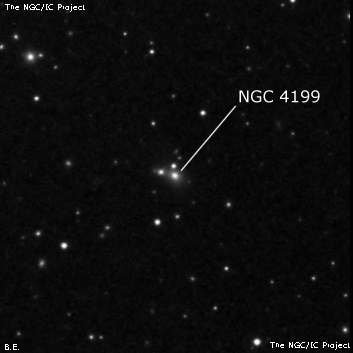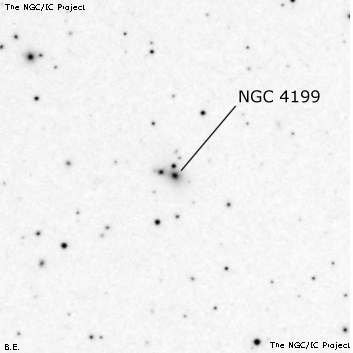NGC/IC Project Restoration Effort
(This is a very very beta version)
NGC4199


Basic Information
Location and Magnitude
Right Ascension: 12:14:48.6
Declination: +59:54:23
Constellation: UMA
Visual Magnitude: 14.3
Historic Information
Discoverer: Herschel W.
Year of discovery: 1789
Discovery aperture: 18.7
Observational
Summary description: vF, S
Sub-type: S?
Corwin's Notes
=====
NGC 4199. Dreyer has a note in his 1912 collection of WH's papers that caught
my curiosity: "Also observed in Sw. 953, Mar. 19, 1790, 76 Ursae p. 27m 59s,
s. 2d 50', or I.253, f. 13m 47s, s. 1d 59'. This agrees well with the place
of Bigourdan, which is = N.G.C. -37s +4'." This seems to suggest that WH
might have seen two nebulae here, not just one.
However, reducing his observations, I find just a single galaxy with
considerable scatter in WH's reduced positions. For 2000, those positions and
the reference objects are:
12 14 31 +59 57.9 69 Ursae Majoris
12 14 26 +59 57.5 71 Ursae Majoris
12 14 44 +59 52.0 76 Ursae Majoris
12 14 44 +59 54.8 I.253 = NGC 4036
Only the last is fairly close to the faint double galaxy that WH must have
seen. It has a superposed star involved, too, that must have enhanced its
visibility a bit. I've taken all three objects as WH's object, though the
southwestern galaxy is the brighter of the pair. While I suggested earlier
that the star might be brighter than either galaxy, it is actually the
second-brightest of the three objects, at least in V. The southwestern galaxy
is therefore almost certainly the object that WH saw.
Bigourdan found the correct object, but made two errors in transcribing his
observations for publication. First, he makes his declination offset negative
instead of positive; and second, he has a -1 minute error in the RA offset
between BD +60 1384 and his actual comparison star, a 12th magnitude star
fortunately picked up in the Astrographic Catalogue zone; this means that we
have a good position for it at an epoch close to Bigourdan's observation
date.
Once these problems are corrected, Bigourdan's position falls within a few
arcsec of the star superposed on the galaxy pair.
The galaxies, by the way, are probably members of the nearby galaxy cluster
Abell 1507. The redshift of the northeastern galaxy is z = 0.0612, while that
of the southwestern is z = 0.0605; the redshift of the cluster is z = 0.0604.
Steve's Notes
=====
NGC 4199
17.5" (5/13/88): very faint, very small. A mag 15 star is involved at the north end just 16" from center and a mag 16 star is involved at the east end 24" from the center. NGC 4195 lies 18' SSW. On the POSS, the mag 16 star I recorded is actually an extremely faint and small companion (VV 183b)!
This is the brightest galaxy in AGC 1507.



